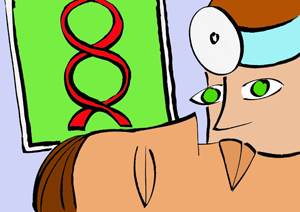Playing God
The Doctor looked at the complex, curving structure on the video screen in front of him. It was beautiful, he thought. The Doctor thought that the structure he could see on the video screen in front of him, on the wall of his small studio was more beautiful than any cathedral or art gallery he had ever seen. Two coloured spirals interlocked with each other. The structure was extremely complex but at the same time incredibly simple. It was a work of art, he thought. Yet this thing hadn’t been created by an artist, but by nature. The double helix of the DNA molecule. First discovered way back in the late 20th century, but present in every cell of every human body since human bodies had existed. Hundreds of thousands of years.
Now, though, it was familiar to everyone, as familiar as the sight of your hand, your computer screen or the sun through the smog over the city.
Since the technology had developed during the 21st century everybody had become familiar with the sight of their own personal DNA structure. Now, every person saw it when they looked at their identity card, where an image of their own DNA was printed, something which was uniquely theirs. For many years, of course, people had manipulated it, changed the structure of their DNA to make them stronger, more resistant to diseases, able to live for ever, almost. People had manipulated the structure of the DNA of their children before the children were born, so that they could look and behave exactly as their parents wanted them. “Designer babies” they were called.
Some people had objected and protested, of course, but it was impossible to change anything. Once a scientific discovery had been made, there was no going back. By the middle of the 21st century though, things were getting difficult. The world’s population had reached breaking point. The planet simply couldn’t sustain any more people. Then the United Nations had passed an international law forbidding any further genetic manipulation or DNA modification. Within a few decades the world’s population stabilised again and once again children began to be born in ways that their parents hadn’t expected – all with different abilities, skin, hair and eye colours.
Most people were happy about this, and rediscovered a world where chance and difference were beautiful things. But other people hadn’t agreed.
The Doctor was one of these people. Once a scientific discovery had been made, he insisted, there was no going back. It was stupid to ignore the effects of progress, thought the Doctor. Progress could not and should not be stopped.
The Doctor, and a few other people like him, had continued to do their work. The Doctor thought that he was continuing to do the work of science and progress, in the face of a hostile and ignorant world. Other people called what he did “backstreet surgery”. It was illegal, of course, but the Doctor secretly quite liked his image as an international criminal.
People who wanted to change their DNA, or that of their children, still managed to find him, and they still came to him. Many people were prepared to risk jail sentences to get what they wanted. The Doctor had a surgery where he continued to operate on such people in secrecy, hidden in the middle of one of the biggest cities in the world. He had done many such operations.
Today was just like any other day for him. A man had come to him with the suspicion that he had a gene which would make it probable that he would develop cancer when he got older. He wanted to change it. The Doctor knew exactly what to do, it was a routine operation for him. Even though it was an operation he had done many times before, though, he was always amazed when he saw the DNA structure of his patient appear on the screen in front of him. Such a beautiful thing, he thought, such a wonder of natural engineering. And now he, the Doctor, was able to make it better. The thought of this, and the sight of his instruments working on the structure filled him with a feeling of power. When he operated on people’s DNA, the very code of their identity, he felt like he was able to change the world.
Today the Doctor felt particularly powerful. He realised that he could do so much more to this man than merely remove one small piece of his genetic code. He could make this man taller, stronger, better, healthier in every way. He could increase his intelligence and make him able to live forever.
Without thinking any more, and clearly without asking his patient, the Doctor began to change more and more things in the man’s genetic code. The Doctor went ahead of himself, doing things he had never done before, taking risks, completely redesigning his patient, doing things even he, the great Doctor, was not sure he knew how to do. But he felt so powerful, he wanted to go on, to go ahead, in the name of science and progress and, yes, in the name of his own genius. Why not? He erased the man’s memory completely. This would be a new man. A new kind of human being would get up from the Doctor’s operating table after this operation.
This man needed a new name. What could the man’s new name be? And as the patient began to recover from the anaesthetic, the Doctor knew what his new name was.
“Adam”, said the Doctor.
